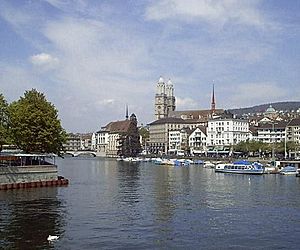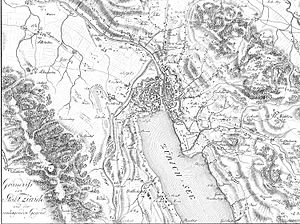First Battle of Zurich facts for kids
Quick facts for kids First Battle of Zurich |
|||||||
|---|---|---|---|---|---|---|---|
| Part of the War of the Second Coalition | |||||||
 Grossmünster church, Zurich. River Limmat, Zürich |
|||||||
|
|||||||
| Belligerents | |||||||
| Commanders and leaders | |||||||
| André Masséna | Archduke Charles of Austria Friedrich Freiherr von Hotze |
||||||
| Strength | |||||||
| 59,000 | 72,000 | ||||||
| Casualties and losses | |||||||
| 500 killed 800 wounded |
730 killed 1,470 wounded 2,200 captured |
||||||
The First Battle of Zurich happened from June 4 to 7, 1799. During this battle, French General André Masséna had to give up the city of Zurich to the Austrians. The Austrian army was led by Archduke Charles. Masséna's forces then moved back across the Limmat river. There, they built strong defenses, leading to a standstill in the fighting.
In 1798, Switzerland became a major battlefield during the French Revolutionary Wars. Later in the summer of 1799, Russian troops joined the fight. They replaced the Austrian soldiers. In the Second Battle of Zurich, the French took back control of Zurich and the rest of Switzerland.
Contents
Why the Battle Happened
Europe's Political Situation
At first, other European rulers thought the French Revolution was just France's problem. But as the revolution grew, they worried about the French royal family. They even threatened France if anything happened to the king. France then declared war on Austria in 1792. This started the War of the First Coalition (1792–1798). France fought against many European countries.
Even though the Coalition won some battles, French General Napoleon Bonaparte pushed Austrian forces back in Italy. This led to peace talks and a treaty in 1797. However, these talks didn't go well. France wanted more land, and other countries didn't want to give it up.
Tensions grew between France and its former enemies. For example, Naples refused to pay money to France, and its people rebelled. France invaded Naples and set up a new government. Also, France encouraged a rebellion in Switzerland. This led to the creation of the Helvetic Republic, a new Swiss government friendly to France.
The French government believed Austria was planning another war. The weaker France seemed, the more Austria, Naples, Russia, and England talked about fighting again. In the spring of 1799, Austria and Tsar Paul of Russia agreed that Russian General Alexander Suvorov would help Austria in Italy with 60,000 soldiers.
Start of the War in 1799
In 1799, France planned to attack on all fronts. This included central Italy, northern Italy, Switzerland, and Germany. France claimed to have 250,000 soldiers, but many were not ready to fight. In March 1799, French General Jean-Baptiste Jourdan crossed the Rhine river with his army. This broke the peace treaty.
Jourdan's army moved into the Black Forest in Germany. By mid-March, they were near the Swiss Plateau. Meanwhile, General André Masséna led 30,000 French troops into Switzerland. He reached the Grison Alps and the Inn river. His plan was to connect with Jourdan's army.
The Austrians had their own armies ready. One force of 46,000 soldiers defended the Tyrol region. Another 26,000 soldiers, led by Friedrich Freiherr von Hotze, guarded the Vorarlberg area. The main Austrian army, with about 80,000 troops, was led by Archduke Charles.
At the battles of Ostrach (March 21) and Stockach (March 25), the main Austrian army pushed the French back. Archduke Charles planned to cross the Rhine river into Switzerland. Hotze also moved some of his troops west to join Charles. They aimed to control the northern entrances to Zürich and fight Masséna's army.
By mid-May, the French soldiers were feeling down. They had lost many men in earlier battles. Also, the Swiss people rebelled against the French again. This made Zürich the last strong place Masséna could defend.
Setting Up for Battle
After pushing the French out of northern Switzerland, Archduke Charles's large army of about 110,000 men crossed the Danube river. They prepared to meet Hotze's forces near Zürich. Masséna, now in charge of all French armies in the area, began moving his troops back to Zürich.
Charles crossed the Rhine with his advanced troops on May 20. Two days later, Hotze crossed with his own forces. On May 23, Charles led more troops across the Rhine.
When Masséna learned of this two-sided attack, he tried to split the Austrian armies. On May 25, he attacked Hotze's troops to the east and Charles's troops to the north. The French pushed back some Austrian units. Even though the French had to retreat when more Austrian soldiers arrived, they caused many more casualties and took prisoners.
On May 27, a French general named Ney was wounded, and his men were forced out of Winterthur. Masséna then gathered all his forces in Zürich, with Archduke Charles and Hotze close behind him.
By the end of May, the French were in position around Zürich. Their defenses were set up in a large semicircle around the city. These defenses were about 5 miles long but were not fully finished. In total, there were about 52,000 French and Swiss soldiers. Charles decided to attack Zürich directly, even though it would be difficult.
The Battle Begins
Jelačić's Attack on Witikon
On June 2, Archduke Charles learned that Hotze's advance troops, led by Jelačić, were already fighting the French near Witikon. Charles sent a message telling Jelačić to wait, but it was too late. By 3:00 am on June 3, Jelačić was already fighting. The battle quickly became very intense.
After four hours, the French were pushed out of Witikon. The fighting continued all day. When things looked bad for the French, Masséna himself led a counter-attack. He carried a musket and led his best soldiers. This combined effort pushed the Austrians back, and the French secured their camp after a bloody fight. The French lost 500 men killed or wounded.
Attack on the Zürichberg
The next day, June 4, Charles crossed the Glatt river and launched a huge attack with five groups of soldiers:
- On the Austrian left, the first group attacked Zürich directly. They broke through a city gate but were pushed back by French soldiers. They couldn't get any further.
- The second group tried to climb the slopes near Hirslanden. But the French fought back and forced them to retreat.
- The third group found their path blocked and had to go around. Their attack failed because of heavy French gunfire from the defenses.
- The fourth group crossed the Glatt river and pushed the French out of Schwamendingen.
- The fifth group captured Seebach and Oerlikon. Part of this group then joined the attack on Zürich.
A French general named Oudinot, even with half his men missing, bravely attacked the Austrian side. After a fierce fight, the French were pushed back, and Oudinot was wounded. Charles's right side of the army stayed back to guard Glattfelden.
On the Zürichberg hill, French soldiers were attacked by three Austrian groups. They were stuck in their trenches. The Austrians attacked again and again, but the French held them off. The fighting turned into a fierce shootout. At 2:00 pm, Charles sent five more battalions, including his own special guards, to storm the hill.
The fighting became hand-to-hand, with soldiers using their musket butts. Finally, at 8:00 pm, after a desperate struggle, the Austrians broke through the French defenses. But the French general Soult and his officers led a counter-attack. They pushed the Austrians back down the hill. Masséna ordered his cannons to fire more and brought up his reserve soldiers. The Austrian attack fell apart, and they were driven back.
During this day, Charles lost 2,000 men, including three generals who were wounded. He also lost 1,200 prisoners. The French lost more than 1,200 killed and wounded.
What Happened Next
After the bloody fighting on June 4, Charles pulled his troops back a short distance. He planned a second attack for June 6. Masséna used June 5 to reorganize his forces. That night, as the Austrians got ready for their attack, Masséna moved his troops to a strong position in front of Zürich. He left behind 28 cannons that he had taken from Zürich. His forces were now closer together, and the lake would force the Austrians to split their army.
The second day of battle never happened. At noon on June 6, after talking things over, the French were allowed to leave Zürich. Masséna moved his army to the Uetliberg mountain and set up his defense along the Limmat river. In Zürich, Charles found 150 cannons. The battle's outcome also caused problems between Austria and Russia. This was because Charles did not follow up on the French defeat.
Both sides lost a general in the battle: Louis Nicolas Hyacinthe Chérin for the French and Olivier Wallis for the Austrians.
See also
- French Revolutionary Wars: Campaigns of 1799




